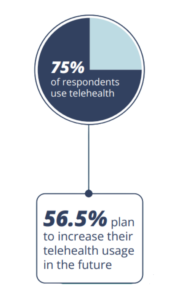In the fall of 2021, the Virginia Telehealth Network conducted a research initiative to better understand how the pandemic was changing the landscape of telehealth as well as pain points and needs of both providers and patients.
 Thanks to partners, including the Virginia Department of Health, Virginia Department of Health Professions and numerous association partners, our team was able to collect invaluable insight from more than 9,200 licensed health care providers across Virginia, the majority of which serving in the behavioral and mental health space.
Thanks to partners, including the Virginia Department of Health, Virginia Department of Health Professions and numerous association partners, our team was able to collect invaluable insight from more than 9,200 licensed health care providers across Virginia, the majority of which serving in the behavioral and mental health space.
The data carries some telling findings. It shows the extent to which telehealth served as a solution throughout the pandemic. (Three in four practitioners say they use telehealth in their practice.) And while the survey sheds light on the disparities that make access to care challenging, even before the advent of COVID-19, there is reason to believe that telehealth will continue to grow. In fact, 57% of survey respondents say they plan to increase telehealth usage in the future.
But before that can happen, providers made it clear the ongoing support needed to ensure telehealth can be conducted efficiently.
Here are the common themes we heard from the pool of survey respondents.
- Telehealth is a solution for both patients and providers with barriers related to schedule and travel.“Our patients can’t afford to take time off work for appointments and transportation is often limited. Telehealth solved both issues for our patients.”“As a free clinic, we rely on volunteers who are providers, interpreters, medical assistants, etc. Telehealth created flexibility for our volunteers to be able to continue volunteering, even when they have moved away. We have volunteers now living in Scotland who still see patients in Virginia.”
“The flexibility in volunteer opportunities at our clinic has attracted more providers and others to give their time. This has sort of created a self-sustaining model and supports the longevity of our free clinic.”
Read more about how telehealth helped Health Brigade reach more patients during the pandemic.
- To be able to conduct telehealth effectively, patients and providers need better access to broadband, tools and technology. Virginia has a plan for expanding access to broadband.“Broadband is a huge issue we experience, especially being in a rural part of Virginia, for both our patients and providers. I know this is a current effort, but it’s important in creating that access to care for our patients who are using their cell minutes and data for virtual appointments.”“Some of the equipment needed for remote monitoring for some of our patients is expensive and difficult to obtain. Many of our patients with pre-existing conditions like hypertension and diabetes need blood pressure cuffs and other tools to help monitor blood oxygen levels, etc.”
- There is a need for patient education around telehealth including how to use technology, proper etiquette during virtual appointments, etc.“We come across digital literacy issues with our patients.”“For behavioral health appointments, many of my clients get easily distracted during virtual appointments.”
- There is a need for provider education, resources and support.“Telehealth allowed me to see more patients, BUT my workload became so high I had to cut back on length of sessions.”“We as providers also need mental health support. We are so burned out.”
“We need education and best practices around telehealth usage in this field of work. I think roundtables would be helpful, as we’re still cracking the code here.”
“Our clinic needs a designated space in our office to be able to conduct telehealth in a quiet, private way.”
“Our free clinic needs more staffing and funding. It takes more manpower to implement telehealth. It takes a lot for our volunteer directors to recruit, train and support the technology aspects. There is an entire infrastructure behind telehealth that needs to be run. We need support for these organizational/ logistical needs.”
Click here to download the full survey report.
For more information, tools and tips about implementing telehealth into your practice, visit VTN’s Equity & Telehealth initiative.

